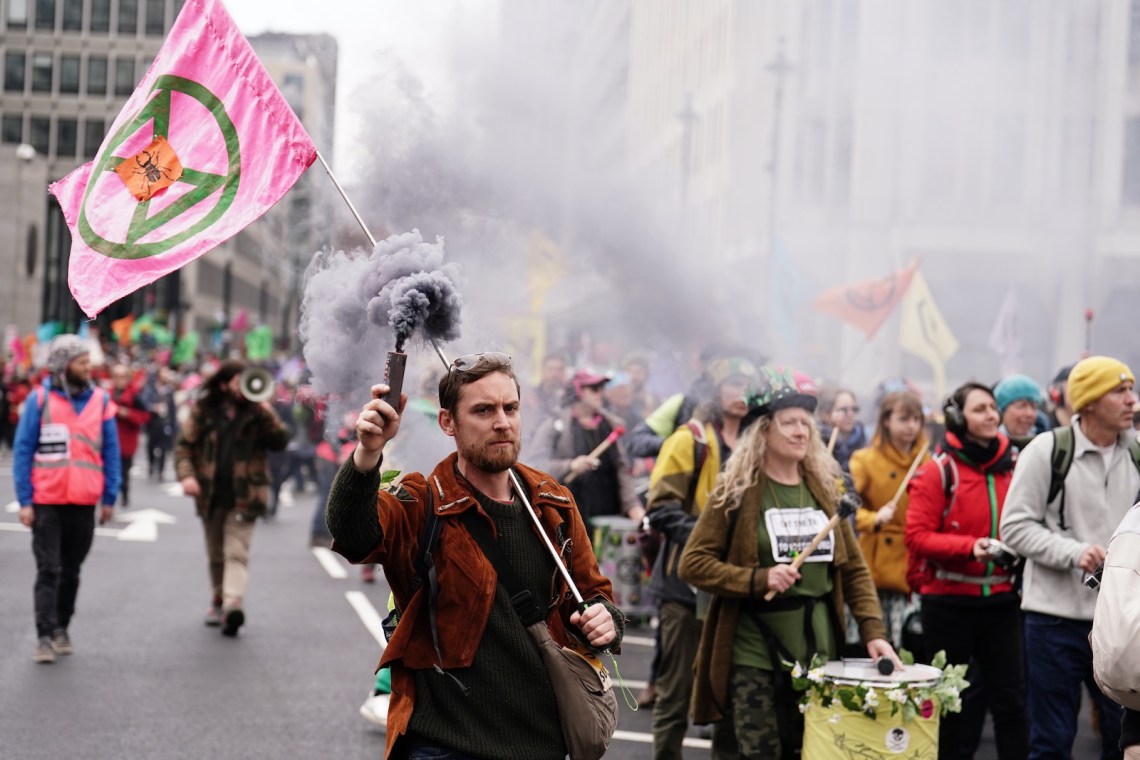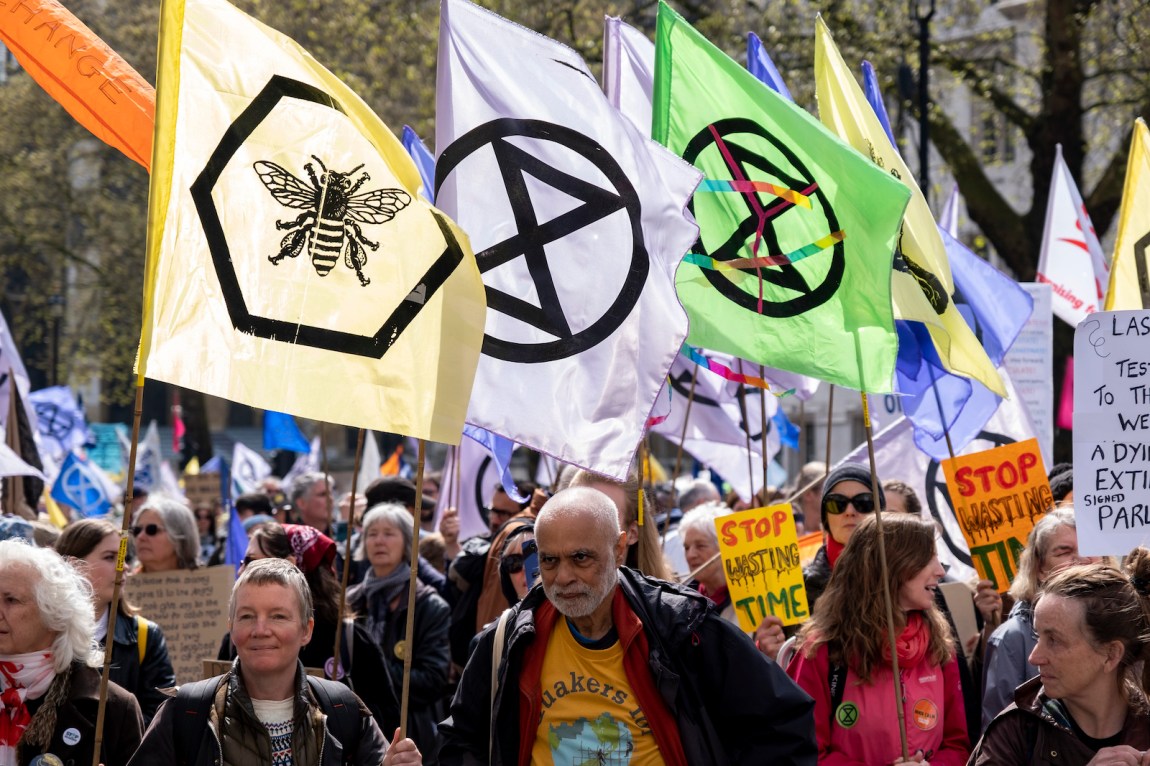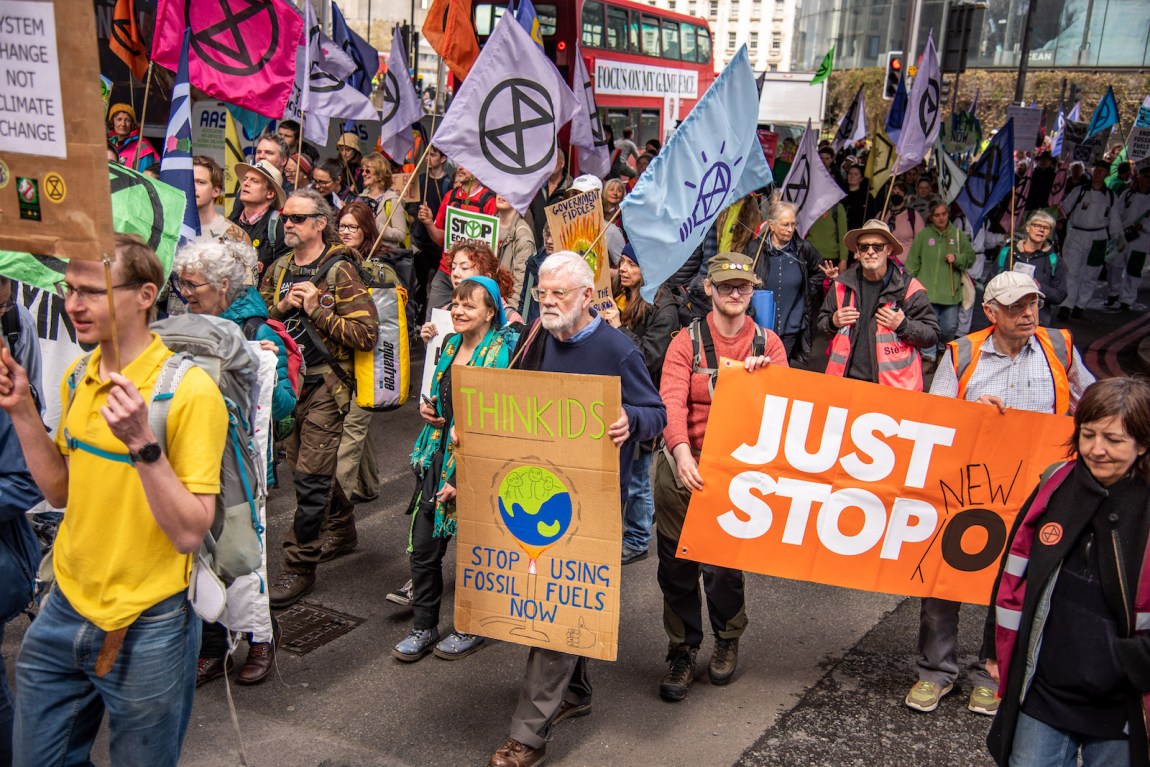On New Year’s Eve, the British arm of Extinction Rebellion posted a statement to its website: “WE QUIT.” The headline was a provocation more than a promise, but it did herald a change in emphasis from the tactics that made the movement for direct climate action famous. “This year,” the statement read, “we prioritise attendance over arrest and relationships over roadblocks.” The new strategy would culminate in April with “The Big One,” an open-ended mass demonstration in the streets around Britain’s Parliament that its organizers placed in the tradition of the protests that precipitated Ukraine’s Orange Revolution and the fall of the Berlin Wall.
Extinction Rebellion pledged to “temporarily shift away from public disruption as a primary tactic”—a departure from prior actions that had seen activists block roads and glue themselves to bridges, which had garnered the group a reputation among many Brits as a nuisance—but made no such promise to those in positions of power. In the weeks that followed, targeted disruptions continued all over the UK: activists dressed as canaries and let off smoke bombs outside a government building in protest of a new coal mine; others spray-painted the offices of right-wing newspapers. At the same time, organizers embarked on a coordinated effort, inspired in part by the Bernie Sanders campaigns, of doorstep conversations and community meetings. They worked to develop ties with more well-established groups both within the environmental movement and across civil society, hoping in part to ride a broader wave of public fury at the depleted state of Britain’s political institutions and public services while linking those failures back to the climate crisis.
In the end, well over a hundred and fifty groups—some of which might not have touched Extinction Rebellion previously—signed up to support the Big One. They included Friends of the Earth, the Catholic Agency for Overseas Development, Britain’s Public and Commercial Services Union, and the global online activist network Avaaz. In one of their first-ever actions, in 2018, activists from Extinction Rebellion had occupied the London offices of Greenpeace, bringing cake and flowers but also charges of “complicity.” Earlier this year, Greenpeace signed on to the Big One. “Previously, other groups hadn’t really engaged with XR as strongly and as actively as they should have done,” in part because “people had their feathers ruffled,” Danni Paffard, the deputy director of logistics at Greenpeace, told me (using a common shorthand for Extinction Rebellion). With its “WE QUIT” statement, Paffard added, Extinction Rebellion showed “humility” and “amazing growth” in “stepping towards the rest of the movement.”
Despite all the people who had signed up, when I arrived on Friday morning for the first of what would be four days of actions, I wondered whether the quitting message had been taken too literally. The weather was drizzly and cold, and while people toting climate placards were visible around the square next to Parliament, they seemed outnumbered by stewards wearing bright pink vests. As I waited for the opening ceremony to start from a makeshift stage on the back of a truck, one attendee described the scene to me as “pretty pathetic.”
Yet as I walked the tight streets of Westminster I came across knots of activity, which seemed to grow in size and volume as the day went on. Many of these were pickets of government ministries; outside the newly formed Department for Energy Security and Net Zero, for example, protesters demanded a halt to a new oil-field project in the North Sea and took part in an act of “discobedience” dancing to “Stayin’ Alive.” On Tufton Street, authors and poets affiliated with the group Writers Rebel gave readings and speeches from a pulpit erected by the steps of a right-wing think tank that has opposed climate-mitigation policies. “‘Evil’ is not a word I use often or lightly,” Zadie Smith told an enthusiastic crowd, “but I believe the kind of pragmatism practiced on this street falls within that category.”
There were scenes familiar from any march or demonstration, like drum circles and colorful signs (“RESPECT YOUR ELDERS,” meaning the tree; “Mother Nature says FUCK THE TORIES”). But there were also rows of street stalls lining the fence outside Parliament, a pop-up bookshop, and talks and roundtables about science and policy for audiences perched on bustling sidewalks. As sunshine finally broke out, I saw families with small children finger painting and young people singing and dancing joyously in bare feet. What had spilled onto the streets was starting to feel like the physical manifestation of a vibrant yet diffuse movement.
*
Five years ago this month Extinction Rebellion was founded in Stroud, a town nestled in a bucolic corner of southern England. It grew out of talks among a small core of activists and academics about how they might mobilize a mass public to support their cause. They drew on the political scientist Erica Chenoweth’s findings that nonviolent movements against repressive regimes are more likely to succeed than violent ones and that movements with the “active and sustained participation” of 3.5 percent of the population have rarely failed. Extinction Rebellion first rocketed to widespread public attention in 2019 when it shut down central London—activists parked a pink boat emblazoned with the slogan TELL THE TRUTH in the middle of one of the city’s busiest intersections—and more than a thousand protesters were arrested. It made three principal demands of the government: to tell the truth about the climate crisis; achieve net-zero emissions and an end to biodiversity loss by 2025; and convene a citizens’ assembly in which a representative “mini public” would be called to make non–legally binding policy recommendations to fight the climate crisis.
Advertisement
The right-wing media, and some of its mainstream counterparts, characterized Extinction Rebellion as a ragtag band of eco-zealot hippies. But the protests captured the zeitgeist—or at least the attention of the media and political elite. Within weeks of Extinction Rebellion’s first major occupations of central London in the spring of 2019, Britain’s Parliament had declared a symbolic “climate emergency.” Extinction Rebellion grew both at the local level and internationally; today it has over a thousand chapters in nearly ninety countries.
Even in those heady days there were tensions. One inflection point came in October 2019, when activists climbed onto the roof of a subway train as it passed through a neighborhood that is home to many working-class people of color—a disturbance that crystallized longer-standing concerns within the movement and on the broader left over Extinction Rebellion’s predominantly white, affluent membership and its lack of a strong, centralized organizational structure. Then came the pandemic, which dealt a blow to the movement’s size, fundraising, and ability to safely convene. Britain’s Conservative government has since passed laws cracking down on disruptive protest.
Extinction Rebellion’s recent pivot to more mainstream tactics builds on the kind of community-level outreach work that it was undertaking as Covid hit. The movement seems to have recognized that its past tactics, while indisputably effective, had run up against their limits. For one thing, Extinction Rebellion had become a household name in the UK, and the climate emergency is now both more immediately visible and a greater public concern. For another, the supply of new activists had dwindled. In response, Extinction Rebellion members, including at the local level, have worked to build relationships with other environmental groups. “In order to open the space up to them, we needed to make them feel safer, and that they wouldn’t be arrested,” Melanie Nazareth, an activist with Extinction Rebellion and Christian Climate Action, told me ahead of the Big One. “One of the problems with the environmental movement is it’s been terribly fractured, and quite siloed. This is an attempt to change that.”
Tactically at least, Extinction Rebellion has recently been outflanked by other groups hewing to a strategy of high-profile public disruption. Earlier this month, the collective Animal Rising disrupted the Grand National, Britain’s most famous horse race; two days later, a protester affiliated with Just Stop Oil mounted a table at an international snooker tournament in Sheffield and covered it in a cloud of orange powder paint. Both actions attracted significant coverage—and no little furious condemnation—across Britain’s mainstream media.
News coverage has often lumped Extinction Rebellion in with these newer groups, which share members with it and in some cases were founded in reaction to it; ahead of the Big One a wave of headlines decried the movement’s supposed plans to ruin the London Marathon, which took a route close to the protests on Sunday, even though Extinction Rebellion had explicitly said that it had no intention of disrupting the race and, indeed, did not. Conversely, Extinction Rebellion and Just Stop Oil have sometimes been portrayed as on opposite sides of a debate in the climate movement between those who consider broadly disruptive action necessary and those who fear it could set the movement back. The day before the Big One, a widely watched morning show invited Clare Farrell, a cofounder of Extinction Rebellion, and James Skeet from Just Stop Oil to debate the question. But the pair refused to disagree and kept steering the conversation, to the consternation of the anchors, back to the climate emergency. The exchange pointed to a middle ground between these media characterizations, one that activists from a range of groups repeatedly stressed to me at the Big One: each group sees the other as a valuable part of a broader whole.
Advertisement
I bumped into Farrell on Friday at an intersection that had been closed off to allow a street party to take place. When I put it to her that Extinction Rebellion has moved in a more mainstream direction, she replied that it was “always set up to be a mass movement,” suggesting that the media had “othered” it and that established charities and civil-society groups had been wrong not to work with it sooner. I suggested that in its present iteration, Extinction Rebellion acts as a bridge between these groups and the likes of Just Stop Oil—and that the latter’s activism had in turn made Extinction Rebellion seem more reasonable. “It’s a shifting landscape,” she said. “It’s called a movement for a reason.”
*
Twenty years ago over a million people marched near Parliament to protest the invasion of Iraq. They didn’t stop the war, but their sheer presence was impossible to ignore, and the march has been credited with making politicians think twice about future interventions. In isolation, the Big One will not be remembered in the same bracket as that march, let alone that of an Alexanderplatz or Maidan. The aim was for 100,000 people—the number of petitioners typically required to raise a question in Parliament—to take part. In the end organizers pegged the turnout for Saturday’s actions at 60,000. The number of participants over the four days might have been higher, though the total is hard to gauge with precision.
And yet the success of the Big One can’t be measured in turnout alone. The 100,000 figure was never do or die: language on Extinction Rebellion’s website called it “a meaningful number for the supposed discourse between voters and their elected representatives” within a political system that Extinction Rebellion wants to overhaul. (Ahead of the Big One, the movement has sought to re-emphasize its long-standing call for a citizens’ assembly—an important part of its agenda that has traditionally flown under the media’s radar—at a moment when the dysfunction of British politics has been more widely apparent than ever.) For all its climactic framing, the Big One is perhaps more usefully viewed as one step on Extinction Rebellion’s transition from radical, attention-grabbing fringe to something more durable, rooted in the less flashy grunt work of relationship-building at the community level and with established fixtures of the country’s civil society. Before the Big One had even taken place, figures in Extinction Rebellion told me that it had already been a success from that point of view.
It was always the plan for Extinction Rebellion to reassess its new strategy after the Big One, and the movement may yet have a different shape even six months from now. Prominent figures have left open the possibility of returning to prior tactics; Extinction Rebellion and some of its partners threatened to “step up” if the government didn’t meet its main demands by the end of Monday, and when that deadline passed Farrell said that the movement would now work to develop “an ecosystem of tactics that includes everyone from first-time protesters to those willing to go to prison.” It isn’t yet entirely clear what this escalation might entail, in no small part because activists must meet to discuss it first. Whatever it looks like, Extinction Rebellion likely won’t—and perhaps can’t—revert to its earlier role as an upstart insurgent after progressing this far down a path toward mainstream acceptance and influence.
On Friday afternoon I spoke with Will, a Just Stop Oil activist who was collecting signatures for a series of “slow marches”—a disruptive but legal way to snarl up roads and sidewalks—that the group was planning in the aftermath of the Big One. “Greenpeace was once the radical flank,” Will told me. “The same was true for Extinction Rebellion, and now it’s not. Just Stop Oil will eventually probably accede to the same fate, but in the meantime, we’re pushing the Overton window.” Extinction Rebellion and its demands are by no means universally popular. But they are, these days, more than ever within the window’s frame.





